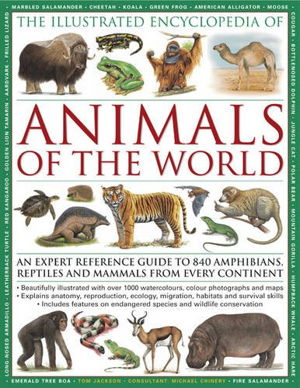
PublishedAnness Publishing, January 2012 |
ISBN9781780191089 |
FormatSoftcover, 512 pages |
Dimensions22cm × 16.8cm × 3cm |
This is an expert reference guide to 840 amphibians, reptiles and mammals from every continent. It is a comprehensive encyclopedia of over 840 animals from North and South America, Africa, Europe, Asia and Australia, all beautifully illustrated with over 1000 commissioned artworks and photographs, and over 800 distribution maps.
From the smallest mouse to the largest whale, this book offers a detailed and thorough guide to an array of reptiles, amphibians and mammals, exploring their habits and habitats. It includes comprehensive biological and environmental data on evolution, anatomy and ecology, with special features on endangered species and wildlife conservation. It features a technical glossary explaining key biological and zoological terms for quick and easy reference. Packed full of facts and detailed illustrations, and featuring over 840 animals from every continent, this is a fascinating family reference guide to the animals that inhabit our world.
Beginning with a biological and evolutionary overview of the animal kingdom, the book examines a huge range of animal characteristics, such as anatomy, survival instincts and reproduction, and takes a closer look at what it means to be an amphibian, reptile or mammal. The second part of the book is divided into accessible chapters describing animals from North and South America, Africa, Europe, Asia and Australia. Over 1000 illustrations, 800 distribution maps and information boxes detailing habitat, diet, size, life span and conservation status accompany the entries.

